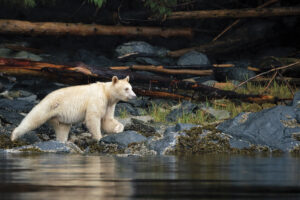
People & Culture
Kahkiihtwaam ee-pee-kiiweehtataahk: Bringing it back home again
The story of how a critically endangered Indigenous language can be saved
- 6310 words
- 26 minutes
This article is over 5 years old and may contain outdated information.
People & Culture


Growing up on the small Norwegian island of Herføl, approximately 120 kilometres south of Oslo, Henry Larsen developed his taste for adventure early in life — although not quite in the way you might expect.
“He used to sail at a very young age,” says Doreen Larsen Riedel, recalling her father’s youthful exploits. “There are stories of his going out to sea in a barrel when he was about eight. He would sail anything that would float.”
And sail he did. Larsen, who immigrated to Canada in 1923, would go on to patrol frigid Arctic waters as a member of the RCMP and, most famously, become the first Canadian to navigate the treacherous Northwest Passage, a feat accomplished 70 years ago this year. The Royal Canadian Geographical Society acknowledged his landmark journey in 1959, awarding him the first-ever Massey Medal for outstanding career achievement in exploration, development or description of the geography of Canada.
As a boy in Norway, Larsen had been captivated by the deeds of fellow countryman and polar explorer Roald Amundsen, who had become the first person ever to successfully navigate the Northwest Passage (1903-1906), and he aspired to follow in his footsteps. “Amundsen was always his big hero,” notes Larsen Riedel. “My father had a photograph of him hanging in his cabin and office at home.”
Soon after joining the RCMP in 1928, Larsen became the master commander of the St. Roch, a 31.8-metre wooden schooner with a reinforced hull that became a floating detachment of sorts, supplying RCMP posts in the western Arctic, carrying out regular police duties and responding to emergencies. It wasn’t until 12 years later, in 1940, that Larsen finally got the chance to emulate Amundsen and navigate through the Northwest Passage, albeit on a west-to-east course — the first person to do so. Apart from the route and the more modern equipment, the biggest difference between the two men’s journeys was the reason for going. Larsen’s voyage was as much about following orders as Amundsen’s was straight-ahead exploration. With the Second World War in full swing, Larsen had been tasked with protecting Canada’s sovereignty at a time when foreign interests posed a serious threat.
The voyage took just over two years to complete, from June 1940 to October 1942, and the crew had to spend the winter of 1940 on the coast of Victoria Island. But that didn’t mark the end of Larsen’s relationship with the passage. Two years later, when the Canadian government ordered Larsen to reconfirm the nation’s Arctic sovereignty, he set off again, this time from Halifax, navigating the St. Roch through the northern Northwest Passage via the Prince of Wales Strait. Larsen completed the voyage in just 86 days, making him not only the first to navigate this more northerly east-to-west route but also the first to complete the passage in one season.
“It was a sovereignty question. There was no two ways about it,” says Larsen Riedel, echoing present-day concerns some have over Canada’s Arctic policy. “You have to be there. You can’t just claim that something is yours without being there.”
Apart from his Northwest Passage trips, Larsen did much to further our understanding of Canada’s North, conducting the earliest salinity readings of the western Arctic Ocean, collecting marine invertebrates and pre-Inuit artifacts and making the first colour-film record of Arctic life.
In June 2006, a successful campaign to create a bronze statue of Larsen concluded with an unveiling ceremony aboard the St. Roch. The patrol schooner, long since retired from service, now resides in an A-frame building inside the Vancouver Maritime Museum. Larsen stands on the boat’s foredeck, sextant in hand.
“This is quite a tribute to a man, which he very well deserved,” says statue campaign co-chair Clyde Jacobs. “Canadian sovereignty, especially in the islands and waters north of the mainland, was very much strengthened by Larsen’s voyages. Through his contributions, he solidified Canada’s sovereign rights to the Arctic coast.”
Are you passionate about Canadian geography?
You can support Canadian Geographic in 3 ways:

People & Culture
The story of how a critically endangered Indigenous language can be saved

Exploration
Caving: The ultimate underground sport

Wildlife
How ‘maas ol, the spirit bear, connects us to the last glacial maximum of the Pacific Northwest

People & Culture
For unhoused residents and those who help them, the pandemic was another wave in a rising tide of challenges